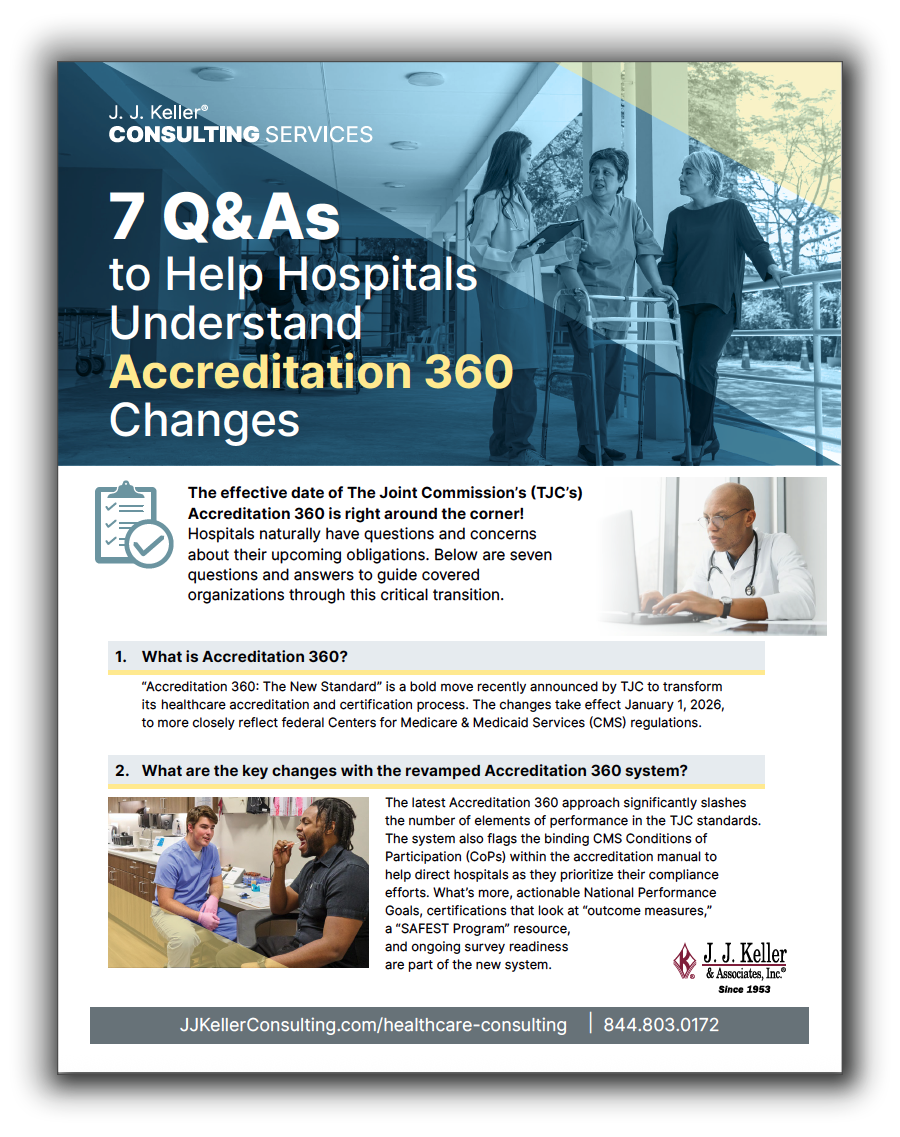Countdown to Joint Commission’s Accreditation 360 Standards Shift
Tricia Hodkiewicz, J. J. Keller® Editor – EHS
Date: 8/18/2025
In a bold move in July to transform its healthcare accreditation and certification process, The Joint Commission (TJC) announced the launch of “Accreditation 360: The New Standard.” Feedback from the federal Centers for Medicare & Medicaid Services (CMS) prompted the longstanding accreditation organization to take action to more closely reflect CMS regulations.
The changes take effect January 1, 2026, giving both hospitals and critical-access hospitals time to ramp up.
While the latest approach significantly slashes the number of TJC standards and is said to simplify the accreditation process, impacted hospitals should not wait until the last minute to get ready for the switch. They’ll need to tackle policy updates, train staff, and make other investments to be fully prepared on day one.
Key changes
According to TJC, the revamped system:
- Removes over 700 elements of performance from the hospital accreditation program and discards almost 650 from the accreditation program for critical-access hospitals;
- Flags the binding CMS Conditions of Participation (CoPs) within the accreditation manual;
- Consolidates the remaining non-CMS requirements and National Patient Safety Goals into a new set of 14 actionable National Performance Goals (NPGs) that go beyond CMS compliance;
- Implements certifications that look at “outcome measures” instead of processes and structures;
- Introduces a “SAFEST Program” resource to hone-in on leading best practices and offer safety/quality insights for greater industry learning and benchmarking; and
- Promotes ongoing survey readiness.
Broader standards “hide” requirements
It’s worth noting that the overhauled TJC standards are not only fewer in number but less prescriptive. The danger is that covered hospitals may think the old requirements have fallen away. However, the broadly worded standards may still encompass all the same “old” requirements, even though they’re no longer found in the text.
What’s more, TJC-adopted codes from the National Fire Protection Association (NFPA) sync up with the codes adopted by CMS. Examples include NFPA 99, Health Care Facilities Code, and NFPA 101, Life Safety Code. However, hospitals should pay attention to whether the TJC standards adopt codes in full; one slip up with any line in a fully adopted code means surveyors have the authority to cite for deficiencies.
New Physical Environment chapter
Hospitals and critical-access hospitals will quickly learn that, under Accreditation 360, the Environment of Care (EC) and Life Safety (LS) chapters are combined to form one chapter called Physical Environment (PE). In this way, these hospitals will ensure a safe environment and protect occupants from fire, together in a cohesive way. For the reimagined PE chapter, TJC:
- Adheres to the CMS CoPs language for less ambiguity;
- Eliminates or consolidates over 40 standards down to just 8;
- Compresses the number of elements of performance by almost 50 percent;
- Replaces Survey Activity Guides with Survey Process Guides; and
- Provides crosswalk pages that aid hospitals as they navigate from the EC and LS standards to the PE standards.
Implications
The new approach may deliver meaningful benefits:
- With fewer standards, paperwork burdens may be reduced in the long term;
- Removing redundancies in the standards will provide efficiencies;
- Clearly calling out in the accreditation manual the standards that align to CMS CoPs will help direct hospitals as they prioritize their compliance efforts;
- Combining the remaining non-CMS standards and safety goals into a set of NPGs makes it easier for hospitals to figure out exactly where they must surpass CMS compliance;
- The emphasis on outcome measures translates to greater value for patients;
- Having best-practice resources means hospitals can learn from their peers and improve performance; and
- Underscoring continued survey readiness will minimize survey disruptions.
Yet, hospitals will need to address several challenge areas during the transition, such as:
- Adapting to unfamiliar standards, including a brand-new PE chapter;
- Retraining staff in the new standards;
- Updating policies and documentation in line with the new standards;
- Interpreting the broader requirements;
- Avoiding deficiencies within adopted codes and consensus standards;
- Getting infrastructure set up to track outcome measures;
- Continuing to value quality of care efforts despite an outcomes focus; and
- Gaining access to new resources from TJC.
Recommendations and next steps
Hospitals will naturally have concerns about what impacts the Accreditation 360 will have on their own policies and procedures. The good news is a consultant or other subject matter expert can help them meet their new compliance obligations.
Also, hospitals should not halt any best practices simply because they’re not listed in the streamlined standards. Those unlisted standards may be “hidden” under generalized standards.
Meanwhile, hospitals should:
- Continue complying with existing TJC standards until January 1, 2026, including the EC and LS chapters;
- Review existing policies and prepare to make updates;
- Train staff in the changes that will take effect January 1;
- Bring the facility into conformance with the prescribed NFPA and other consensus standards;
- Put in place systems and/or forms to capture outcome measures; and
- Watch for news and review resources on the changes and how TJC will cite the new standards.
Need help complying with these changes? Learn about J. J. Keller's Healthcare Safety Consulting Services or CALL 844.803.0172

